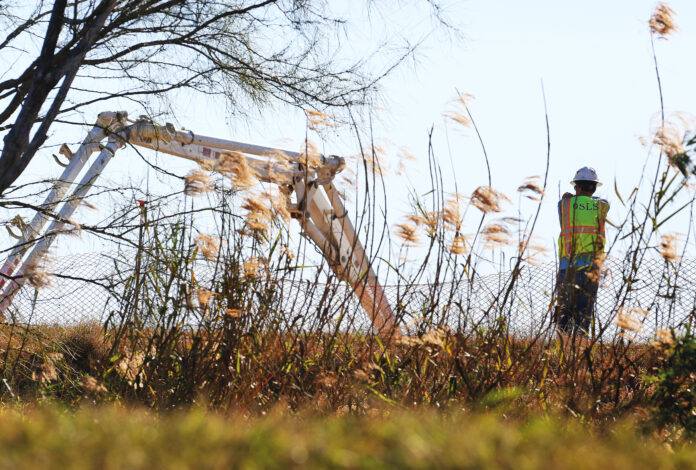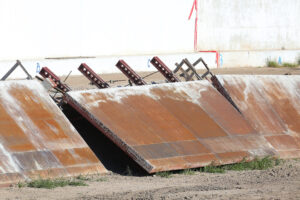
Whatever stretches of border wall are currently under construction in Hidalgo and Starr Counties, they are the last portions of wall that will go up. And any land previously slated for construction that has been thus far untouched will remain so moving forward.
That was the message officials had in federal court as District Judge Randy Crane presided over hearings for more than a dozen land condemnation lawsuits Friday morning.

“We are getting near the end of most of the actual wall construction parts,” said Assistant U.S. Attorney John A. Smith III in response to a question Crane asked as the slew of hearings came to a close.
All that’s left, Smith said, is for the projects currently under construction to wrap up, and for officials to decide where and what type of access gates to install.
“The real issue amongst the administration and Border Patrol is the gaps in the wall — are there gonna be gaps in the wall, are there gonna be gates, no gates? … If there will, they’ll be a modified type of gate, not the big moving gate, but more like a ranch gate type of thing,” Smith said.
The impromptu announcement comes as the first real policy shift after officials were left confused and directionless in the wake of a January 2021 presidential executive order.
On his first day in office, President Joe Biden issued an executive order halting all border wall construction.
But the order was temporary, and once it expired, neither government attorneys nor the hundreds of landowners they were suing knew what would happen to the tracts of land that had been earmarked for border wall construction.
While campaigning, Biden had promised “not one more foot” of wall would be built. But amidst the lack of guidance last spring, one family — the Cavazos family — saw a judge here grant the government final possession of their riverside land south of Mission.
Around the same time, local leaders had begun to sound the alarm about portions of the flood control levee system that had been damaged during 2020’s Hurricane Hanna. The outcry left the Department of Homeland Security scrambling to send repair crews.
That work was completed within weeks, but afterward, heavy machinery could still be seen at various locations along the levee system, where construction began in places where none had previously occurred.
It was done under the guise of continued levee repairs, but for local anti-border wall activists like Scott Nicol, its purpose was clear: the border wall was still going up under Biden, despite his campaign promises to the contrary.
The new construction was reminiscent of wall constructed under former President Donald Trump, which featured 18-foot tall steel bollards atop vertical slabs of rebar-reinforced concrete installed on the crests of the levees. The only difference between Trump wall and Biden’s “levee repairs” were that the new structure featured smaller, 6-foot tall bollards.
Meanwhile, in court, the government attorneys charged with pursuing the land condemnation cases could offer no definitive answers about the fate of the lawsuits because they had received no administrative guidance themselves.
Smith, of the U.S. Attorney’s Office Corpus Christi Division, is perhaps the foremost expert on such litigation, having pursued condemnation cases since the George W. Bush administration.
Despite that, even he often couldn’t provide clarity when asked by federal judges here in McAllen — until Friday.
“Along the levee where there was yet to have construction commence… is there any attempt by the government or any indication that the government is gonna sort of reinforce these levee walls?” asked Crane, the judge.
“So, if there has not, at this time, by this date, if there hasn’t been any movement of the earth, of the levee, then there won’t be a wall going into that area,” Smith replied, adding that the only potential exception are locations where so-called “transition work” needs to be completed to round off the end points of construction.
“We call that transition work, so some of that is going on, but there shouldn’t be any place now where they’re going to actually dig up the levee and start putting in a wall. Those all should be under construction at this point,” Smith said.
But that has not been the case on the ground, contends Nicol, the local activist.
Nicol claims new portions of border wall construction are still going up, despite the representations made in court this week.
“On the day he (Smith) is saying that, they were excavating levee heading towards the butterfly center,” Nicol said via phone Saturday of a portion of wall near Schuerbach Road.
“The construction had stopped midway, they had backfilled the levee, they had shored up the transition point. And on the day he was saying that to the court, they were excavating levee to build new border wall,” Nicol said.
Nicol routinely visits the site to track construction activity. Crews had completed work in the area in October, he said. They had packed up their equipment and left.
But on Jan. 1, they returned and began work on undamaged, untouched levee.
“Construction is just about as active now as it was under Trump,” Nicol said.
The mixed signals continued in court Friday.
In the 16 hearings Crane presided over that morning, all indications pointed toward many of those landowners getting their land back, just as Smith would go on to say at the hearings’ conclusion.
“This is an area of Hidalgo County where no barrier has been constructed. We’ve been in communications with District 9, and the government is in the process of working out a joint stipulation for revestment,” Assistant U.S. Attorney Baltazar Salazar said during one particular case.
Salazar was referring to a land condemnation suit filed against the Hidalgo and Cameron Counties Irrigation District 9 concerning just over 37 acres of land in rural Mercedes.
Weslaco attorney Lance A. Kirby expressed the irrigation district’s thoughts on getting its land back.
“We’ve wanted all along to revest entirely because we have our intake of water into that 800-acre reservoir and we don’t want that messed up. We thought their plans were gonna mess it up,” Kirby said, referring to the potential for border wall to have crisscrossed those 37 acres.



